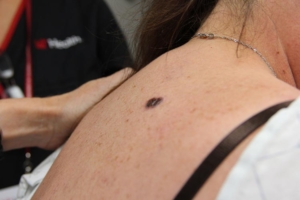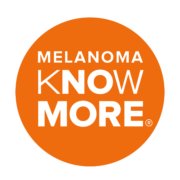Prevention
Exposure to the sun’s ultraviolet (UV) rays appears to be the most important environmental factor involved in the development of skin cancer, including melanoma. It is also the one factor that is most easily controlled. When used consistently, sun-protective practices can prevent skin cancer. UV rays from artificial sources of light, such as tanning beds and sunlamps, are as dangerous if not more so, as those from the sun and should also be avoided. There is no “safe” tan. Although both tanning and burning can increase a person’s risk for skin cancer, most Americans do not consistently protect themselves from UV rays.
Melanoma is an extremely preventable cancer when taking the following precautions:
- Protect your skin.
- Avoid sunburns.
- Limit sun exposure, especially between the hours of 11 a.m.- 4 p.m. when the sun is the strongest
- Wear protective clothing – such as long sleeves and hats – when exposed to sunlight
- Use at least a SPF 30 sunscreen – applying 30 minutes before going out and 1-2 hours thereafter.
- Look for a sunscreen that protects against both types of ultraviolet radiation in the sun’s rays-UVA and UVB.
- Use a higher SPF when you are at higher elevations.
- Avoid sunbathing and tanning salons. Studies suggest that your risk of melanoma increases by 75% if you start using artificial tanning before you are 30 years old.
- Examine your skin regularly, and have your doctor check your skin during all other health exams, or at least once a year or visit one of Melanoma Know More’s free monthly skin cancer screening clinics.
- Use sunscreen as a part of your daily moisturizing ritual.
- Set a good example for your children by protecting your skin from too much sun.
Risk Factors
Family History
Those with a family history, i.e. first degree relative, have 2-3 times the risk of developing a melanoma and with more than one first degree relative with melanoma, the incidence is even higher.
Moles and Having an Atypical (Dysplastic) Nevi
The number and size of moles increases the risk of developing melanoma. Also, atypical or dysplastic moles (nevi) are a common genetic disorder. People with these nevus’s usually have several large moles with more than one color and they typically develop in childhood and increase in size and number through adolescence. If you have these moles and have a genetic predisposition to melanoma, you are at an especially high risk for developing melanoma and should be followed regularly by a dermatologist. Also, encourage your family members to get their skin checked.
Being Born with a Mole(s)
Some infants are born with a mole called a nevomelanocytic congenital nevus or having neurocutaneous melanosis puts a person at increased risk for developing melanoma. Larger moles increase the risk of developing melanoma.
Parents should consult with their Pediatrician and/or Pediatric Dermatologist to determine the appropriate medical plan when dealing with these moles.
Personal History
Developing one melanoma increases the risk of developing another melanoma.
Skin Type
Caucasians are 20% more likely than African Americans to develop melanoma because they do not produce as much pigment to protect them from UV exposure. Fair-skinned, red-haired, blue/green-eyed people have a higher incidence of melanoma.
Being a White Male Over Age 50
People of any race and age can get melanoma, white men are at particularly higher risk. Melanomas on white men are most often found on the back. Also pay close attention to moles on the scalp, since melanomas on the scalp have a higher mortality rate than elsewhere, because they are usually diagnosed at a more advanced stage.
Ultraviolet (UV) Light Exposure
Frequent and intense exposure either from sun or artificial indoor tanning beds is a major risk factor for developing melanoma. The more blistering sunburns, particularly before 18 years of age, increases the risk of developing melanoma.
